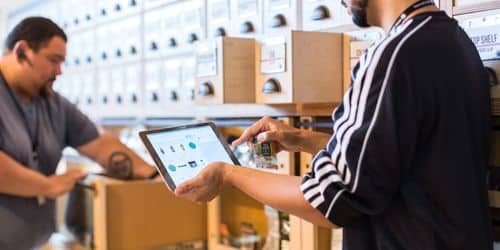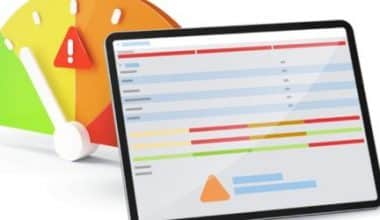The most fundamental duty of any retail business owner, big or little, is to make sure that the proper stock is available in the right quantities. To fulfill this duty, your stock management system must have accurate inventory tracking. This article explains what a barcode inventory tracking system is. It also gives you a highlight of the inventory tracking system for small businesses and retail inventory tracking systems that would be useful for you.
Inventory Tracking System
The practice of a company regularly tracking every item of inventory it possesses is known as inventory tracking. Although the term “inventory” has many meanings, the most typical ones are “raw materials,” “unfinished goods,” and “ready-to-sell” commodities. You get access to data like your precise inventory levels, the location of each item or SKU, up-to-date delivery statuses, and other inventory-related information with inventory tracking. Every place of a company that interacts with inventory has inventory tracking, including manufacturing and production firms, warehouses, retail outlets, etc.
It’s never been more crucial to make sure that customers can acquire what they want with the least amount of work, especially with online retail behemoths, placing small firms in the e-commerce sector under great pressure. If customers can’t find what they’re looking for, they’ll undoubtedly find it fairly easily from a competitor custom you’ll find it difficult to win back.
Therefore, it is crucial to managing inventories effectively. In order to properly monitor stock levels and account for changes in consumer demand, your inventory management system must also be up to the task. In order to maximize client lifetime value and fulfill escalating consumer expectations, this is, however, essential.
Barcode Inventory Tracking System
An efficient way for firms to track inventory is via a barcode inventory tracking system. When a product contains a barcode, it is scanned and immediately synchronized with inventory management software using a handheld mobile device.
Although managing inventory by hand or with spreadsheets is an option, doing so is labor-intensive and prone to human mistakes. For this reason, a lot of companies use barcoding to manage their inventory more effectively. There are two types of barcodes inventory tracking system:
#1. 1D Barcodes
Consumer goods frequently have one-dimensional barcodes, which are the most prevalent kind of barcode. Labels for 1D barcodes feature a distinctive design of vertical black lines against a white backdrop. The line spacing enables the barcode scanner to recognize the product information.
#2. 2D barcodes
Patterns of dots, squares, and other shapes are used in two-dimensional barcodes to encode data. These barcodes may hold more data than 1D barcodes, such as website information, photos, and audio, thanks to their intricate layouts. People may scan QR codes with their smartphones to access websites, making them one of the most prevalent types of 2D barcodes.
How Does Barcodes Inventory Tracking Operate?
The suitability of a barcode inventory system for your company must be established before implementation. This system will probably be useful if you oversee any kind of physical inventory.
- You keep inventory at a warehouse: Handling hundreds or even thousands of products without a mechanism to keep track of them might be challenging.
- Barcodes are necessary for the products your vendors or merchants buy from you, even if you can function without an inventory management system that uses barcodes.
Why Are Barcodes Inventory Tracking Used?
When a firm grows more sophisticated, some tasks must be automated in order to stay up with demand. For two reasons, inventory control fits within this category:
- Manual inventory counts are tiresome and consume resources that may be used for more productive endeavors.
- Maintaining inventory levels by hand increases the possibility of human mistakes, which can lead to expensive errors, omissions, and lost material.
Both of these issues can be resolved with a barcoding system. You may quickly update your inventory records by scanning the barcode rather than manually entering SKUs into a spreadsheet. In the time it would take to manually input a few characters, you could track dozens of items.
How to Start Utilizing a Barcode Inventory Tracking System for Small Business
Here is how to use a barcode inventory tracking system for small business:
#1. Establish Your SKUs
It is now time to construct a database of your stock-keeping units (SKUs) or universal product codes (UPCs) in order to make inventory management simpler. Each item in an inventory should have one or more of the following descriptors:
- Sizes of the goods
- Purchasing cost
- The very minimum you require for your inventory
- An item’s physical description
#2. Choose a Barcoding Inventory Tracking System
Without a software system for inventory management, barcodes are useless. To decrease errors and further automate your company processes, QuickBooks Enterprise includes barcode scanning capabilities.
#3. Choose the Kinds of Barcodes You Want to Employ
The choice of barcode relies on how much data you need to encode into them. 1D barcodes should be adequate if you only need to track a modest amount of data and have a small amount of inventory.
#4. Make Your Barcodes Now
To create the barcodes that go with your inventory, use your inventory software system. A barcode generator in QuickBooks Enterprise generates a special code for each item.
#5. Put Barcodes on Your Inventory
The easiest and most crucial step in the procedure is this one. Use a barcode printer to print your labels, then stick them to each item. Ensure that the tag is visible so that it may be quickly scanned.
Inventory Tracking System for Small Business
As we know the importance of an inventory tracking system for Small businesses, why not get one for your small business today? Confused about the one to go for? Here is the inventory tracking system for Small business you can go for:
#1. Periodic Inventory Management
If you’re looking for an alternative to daily inventory management, consider switching to a periodic inventory system. This can happen every week, every month, every quarter, or every year. You do not need Inventory management software for the system. Instead, every item in the inventory is manually counted and recorded in journal entries.
The benefit of adopting a periodic inventory management system is that it’s easy to set up and maintain. It is therefore perfect for small enterprises that don’t maintain significant inventories.
#2. Perpetual Inventory Management
Systems for managing inventory perpetually keep track of inventory. This implies that when things are purchased or new inventory is received, modifications to inventory levels are done automatically, and purchases and returns are immediately recorded in your inventory accounts. Businesses need software, typically a POS system or inventory management software, in order to use the perpetual system.
The key advantages of a perpetual inventory management system are not having to create closure entries and always seeing the most up-to-date information about stock levels, which helps organizations order just the correct amount of goods.
#3. Barcode Inventory Tracking System
Each product sold is identified by a number using barcode inventory systems. The manufacturer and supplier of the goods, their location, weight, the quantity of each item in stock, and other details can all be represented by the barcode numbers.
The use of barcode inventory systems is related to ongoing inventory counts. The inventory program can be used to scan each product’s unique barcode when it is bought, sold, or transported. This instantly changes inventory levels and other data.
#4. Radio Frequency Identification (RFID) Systems
Radio waves are transmitted from a reading device to a tag (a small microchip) in RFID technology. The tag’s data, which often comprises an inventory identification number or product-specific data like stock and batch numbers and manufacture dates, is read by the reader.
Barcode systems are improved upon by RFID inventory systems. They don’t require line-of-sight scanning and can read tags from 40 feet away. RFID systems are a suitable option because of this for companies that run large-stock, multi-level warehouses or distribution facilities.
Retail Inventory Tracking System
With a retail inventory tracking system, you may properly and efficiently manage your goods. Inventory management systems are used by retailers to streamline and automate the inventory process for their every day shop operations.
Purchase order management, low-stock warnings, transfer orders, bundling, multi-location inventory, multi-channel stock synchronization, landing cost allocation, stock takes, and inventory reporting capabilities are common features of the software. You can keep track of your inventory, sync sales, and stock levels, and determine what to refill and when. Your supply chain will be more efficient and your sales performance will increase with a competent retail inventory management system. Here goes the retail inventory tracking system you need to know
#1. Magestore
A robust inventory management system is included in the point of sale (POS) system known as Magestore. It is native to Magento and functions well for omnichannel shops to synchronize all distribution and sales channels. With simple access from any device and browser, you can centralize all activities and data under one backend. This gives your retail store flexibility and security.
#2. Shopify
Regardless of location, Shopify’s eCommerce platform enables business owners to sell more of their items online. It provides a virtual storefront with professional themes and a web-based website builder where you can manage product listings and develop your brand.
It has a reputation for providing simple payment options, seamless interfaces, and efficient operational management, including product monitoring, store management, and performance statistics. The fundamental inventory control functions for retailers are provided by the Shopify inventory management system, which is included in the package.
#3. Lightspeed Retail
For small retail stores, Lightspeed combines inventory management and point-of-sale software. Through connectivity between orders placed in-person and online, Lightspeed, a platform designed exclusively for brick-and-mortar and online stores, assists companies in keeping track of their inventory and sales. It is a complete mobile cloud-based solution that enhances the management of your stores and customer service while streamlining your supply chain.
Lightspeed Retail provides great inventory management software in addition to its main offering, which is the point of sale. Together with several connectors, it can manage purchase orders, maintain inventory, and complete customer orders. With a laptop, iPad, or mobile phone, you may manage inventory, clients, staff, and sales.
#4. Square for Retail
A cloud-based point-of-sale system for retailers called Square for Retail has functionality similar to retail inventory software. Square provides store owners with relevant insights and data, processes transactions swiftly, and makes inventory management simple. This inventory management system is the most widely used and recommended for new business owners. For retail organizations, Square offers a full register service, a variety of strong features, and an easy-to-use interface.
Controlling inventories, processing payments, managing client relationships, reporting, and personnel management are important functions. Any Square gear can integrate with Square’s built-in payment processing feature.
#5. Vend POS
Vend is a POS and retail inventory software that runs in the cloud and can scale to accommodate any kind of business in the retail sector. It can help you manage your business in-store, online, and on the go, whether you run a small, medium, or large retail establishment. A vast variety of capabilities are available in the software to manage sales, inventory, customer information, and customer experiences. It features a specific app for iOS devices and is compatible with a variety of gadgets, including PCs, Macs, and iPads.
For retail business owners, Vend effectively acts as a one-stop shop. Its pricing is fair and flexible enough to accommodate various businesses’ needs and resources.
What Exactly Is Being Tracked?
Generally, an inventory tracking system can keep an eye on the following data:
#1. A Current Stock Count
The quantity of each resource you own is shown by this number. This information must be continually updated so that you can determine whether you have enough stock for all of your business operations, including the production of new products and the fulfillment of client orders. Furthermore, the additional data that is tracked has a foundation in your stock levels.
#2. Locations for Stock
Your stock shouldn’t stay in one place for too long, even in the best-case scenario. (If it does, it has either turned into slow-moving stock or dead stock.) As soon as the inventory reaches your warehouse, it is moved around as it is sorted and categorized, then stored, and finally retrieved and transferred to the following step in your supply chain. Since your stock doesn’t stay in one spot all the time, it’s critical to maintain track of where it is so that you can locate it quickly in an emergency.
#3. Inventory Precision
The ratio between the amount of inventory that has been tracked and the amount of inventory that is physically present in your possession is referred to as a KPI (Key Performance Indicator). Although it is ideal for both numbers to match, there may be differences due to issues like theft, damage, errors in calculation, and supplier shortages. You can gauge the size of these differences by looking at inventory accuracy. For your business processes to run effectively, inventory accuracy is just as important as stock levels.
#4. Costs of Carrying
This is the overall sum of money spent on holding, storing, and owning your goods. You should factor in how much you spend on security, personnel, storage, and related expenses. You may determine how long your company can keep this inventory on hand before you start to lose money as a result by looking at your carrying expenses. The two main causes of high carrying costs are slow-moving inventory and dead stock, therefore you’ll need to find a means to remove or sell the things if you want to lower your carrying costs.
#5. Inventory Assessment
During the preparation of a company’s financial statements, this procedure is used to determine the worth of unsold inventory. Your remaining inventory is given a financial value through inventory valuation, which must be included on your balance sheet. Moreover, this can be used to compute your inventory turnover.
#6. Inventory Movement
The rate at which your goods are sold is known as inventory turnover. Stronger sales are indicated by a greater value, and worse sales are indicated by a lower value. If your company is doing well or if your sales approach needs to be improved, inventory turnover can inform you. To determine yours, use our free inventory turnover calculator.
#7. Rearrange Levels
The precise level of stock for a certain item below which it needs to be refilled or replaced is known as a reorder point or level. Reorder points are necessary to avoid stockouts (situations where a seller runs out of stock).
Why Is Inventory Tracking System Necessary?
Inventory tracking system is necessary because:
#1. An Improved Stock Visibility
You can keep track of each and every one of your products as they move through your warehouse or storage facility, from the time they arrive to the moment they depart, using inventory tracking. You will thus have access to information about each product’s current location, stock levels, pertinent purchase and sales orders, etc.
#2. Prevent Shortages
You can determine what you don’t have and refill your supply in time if you have a precise tally of your possessions. By doing this, you can prevent running out of supplies and losing out on worthwhile sales. In a Peoplevox poll, 34% of companies said they delivered orders late because they didn’t have the items in stock, even if they were unaware of this at the time the order was placed.
#3. Improved Inventory Forecasts
You can foresee how much inventory you’ll require to meet future demand if you have an accurate count of your inventory at various points throughout the year. This might assist you in making sensible shopping choices and preventing overstocking or understocking. Businesses may save their inventory expenditures by 10% by avoiding overstocking and understocking, according to a McKinsey & Company analysis.
#4. Tracking Several Locations
It can be challenging for businesses to keep track of their stock if they use different warehouses or storage facilities to hold their goods. You’ll have longer strings of location information, more areas to misplace items, more places to count shelves, more sites to arrange delivery from, and so on if you have multiple warehouses. This is why some systems allow you to track numerous stores from the same interface. The intricacy of this data can be significantly decreased by having all of your data accessible in one location.
#5. More Rapid Error Detection
You may spot abnormalities early on, whether they represent mistakes, declines or rises in sales, or unforeseen costs, by consistently monitoring your inventory levels. If you can identify these problems before they become serious, you can fix them.
Even though inventory monitoring seems like a fairly straightforward operation, it can be rather challenging when there are more products involved, as is the situation for larger firms. Manually tracking your stuff is no longer an option beyond a certain point. A method for tracking inventory could be helpful in this situation. Software that assists you in keeping track of the movement and location of your inventory is called an inventory tracking system. Even while there are some standalone systems used just for inventory tracking, the majority of inventory tracking systems are actually a component of inventory management software.
What Is the Best Program to Keep Track of Inventory?
Here is the best program to keep track of inventory:
- Best Overall: Cin7 Orderhive.
- Best for B2B Companies: inFlow.
- Best for Retail Stores: Lightspeed Retail.
- Best for Restaurants: Upserve.
- Best for Manufacturing: Megaventory.
- Best Free Option: Zoho Inventory.
What Is the Easiest Way to Track Inventory?
Using a reliable, user-friendly inventory management software system is the best method to keep track of your inventory. You can also use barcodes and QR codes to automate otherwise time-consuming, error-prone operations, receive real-time notifications, add significant photographs to your inventory list, and more using inventory management software.
How Do I Manage Inventory in Excel?
Here is how to manage inventory in excel:
- Avoid pitfalls and mistakes with Excel inventory
- Update immediately
- Use the cloud
- Take the time to consolidate data
- Review your data
- Audit and review
- Know when to upgrade
What Are the 5 Steps to Effective Inventory Systems?
The following are the 5 steps to effective inventory systems:
- Create a System to Get Accurate and Accessible Information on Your Inventory
- Create a Unique Process Customized for Your Business Type
- Keep an eye on Contemporary trends in the industry
- Be prepared for fluctuations in supply and demand
Final Thoughts
Even in the best of circumstances, it can be difficult to keep your consumers satisfied. This difficulty is only increasing. The correct inventory management software can provide you with a wealth of advantages, such as improved productivity, more efficiency, and clearer visibility. Nevertheless, the true winners will unknowingly be your consumers because of these advantages.
Related Articles
- BEST APPS FOR INVENTORY MANAGEMENT IN 2023
- Best 15+ INVENTORY SYSTEMS FOR SMALL BUSINESS in 2023 (+ Free Options)
- INVENTORY CONTROL MANAGEMENT & SYSTEM: Best Practices
- INVENTORY MANAGEMENT SYSTEM: How to Create an Excel Inventory Management System
- PROJECT TRACKING SOFTWARE: Reviews of Top 25 Project Tracking Software






